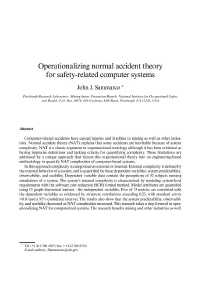Mining Publication: Operationalizing Normal Accident Theory for Safety-Related Computer Systems
Original creation date: November 2005
Computer-related accidents have caused injuries and fatalities in mining, as well as other industries. Normal accident theory (NAT) explains that some accidents are inevitable because of system complexity. NAT is a classic argument in organizational sociology, although it has been criticized as having imprecise definitions and lacking criteria for quantifying complexity. These limitations are addressed by a unique approach that recasts this organizational theory into an engineering-based methodology to quantify NAT complexities of computer-based systems. In this approach, complexity is categorized as external or internal. External complexity is defined by the external behavior of a system and is quantified by the following dependent variables: system predictability, observability, and usability. Dependent variable data contain the perceptions of 32 subjects running simulations of a system. The system's internal complexity is characterized by modeling system-level requirements with the software cost reduction (SCR) formal method. Model attributes are quantified using 15 graph-theoretical metrics--the independent variables. Five of 15 metrics are correlated with the dependent variables as evidenced by structure correlations exceeding 0.25, with standard errors <0.10 and a 95% confidence interval. The results also show that the system predictability, observability, and usability decreased as NAT complexities increased. This research takes a step forward in operationalizing NAT for computerized systems. The research benefits mining and other industries as well.
Authors: JJ Sammarco
Peer Reviewed Journal Article - November 2005
NIOSHTIC2 Number: 20028811
Saf Sci 2005 Nov; 43(9):697-714
See Also
- The Availability of Primary Copper in Market Economy Countries: A Minerals Availability Appraisal
- Evaluation of the Relative Importance of Coalbed Reservoir Parameters for Prediction of Methane Inflow Rates During Mining of Longwall Development Entries
- MCP - Methane Control and Prediction - 2.0
- Nature and Cost of Low Back Pain
- New Web Application: Safety Pays in Mining
- Physical Strength Assessment in Ergonomics
- Reservoir Engineering Considerations for Coal Seam Degasification and Methane Control in Underground Mines
- Safety Pays in Mining
- Technology News 558 - Safety Pays in Mining: a Web Application that Demonstrates the Financial Impact of Injuries
- Thermal Stability of ANFO Made with Recycled Oil
- Content source: National Institute for Occupational Safety and Health, Mining Program


 ShareCompartir
ShareCompartir
